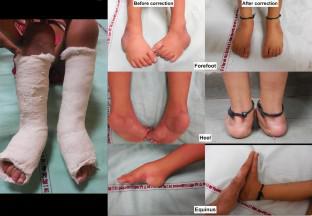Indian Journal of Orthopaedics ( IF 1.1 ) Pub Date : 2022-09-06 , DOI: 10.1007/s43465-022-00732-2 Akhil Agnihotri 1 , Arvind Kumar 2, 3 , Suresh Chand 4 , Anil Mehtani 1 , Alok Sud 1 , Siddhartha Sinha 2

|
Purpose
Above-knee casts pose a major challenge in the day-to-day activities among walking age clubfoot patients due to complete restriction of knee movement. This current study investigates the effectiveness of below-knee casts compared to above-knee casts for managing walking age clubfoot deformity.
Methods
After approval from the institutional ethical committee, we enrolled walking age clubfoot patients for deformity correction through corrective manipulation and casting through below-knee casts over 2 years. The corrective manipulation was performed using the Ponseti technique. The patients were followed for a minimum of 2 years period. To compare the effectiveness of below-knee casts over above-knee casts, we enrolled equal numbers of walking age clubfeet matched for age and gender. We compared the two groups in terms of initial and post-correction Dimeglio scores, individual deformities corrections (maximum ankle dorsiflexion, heel varus correction, foot abduction), failure rates, relapses, and complication rates.
Results
56 patients with 80 clubfeet with a mean follow-up of 39.98 months were considered for the final analysis. There were 29 patients in the below-knee cast group and 27 in the above-knee cast group, with 40 clubfeet each. The patients in the above-knee casting group had significantly better post-correction Dimeglio scores and individual deformity components corrections than the below-knee cast group. There were nil failures in the above-knee casting group and 7.5% in the below-knee cast group. The relapse rate was 15% in both groups, with none requiring any extensive soft tissue procedure. We did not encounter any major complications during the treatment and follow-up.
Conclusion
The deformity correction and maintenance are suboptimal with the below-knee casts. Therefore, above-knee casts should be the preferred management modality for correction of walking age clubfoot deformities.
中文翻译:

膝下石膏对步行年龄儿童的马蹄内翻足管理有效吗?前瞻性队列研究
目的
由于膝盖运动完全受到限制,膝上石膏对步行年龄的马蹄内翻足患者的日常活动构成了重大挑战。目前的这项研究调查了膝下石膏与膝上石膏相比,在控制步行年龄马蹄内翻足畸形方面的有效性。
方法
经机构伦理委员会批准后,我们招募了步行年龄的马蹄内翻足患者,通过矫正手法和膝下石膏进行石膏矫正,历时两年。使用潘塞蒂技术进行矫正操作。对患者进行至少2年的随访。为了比较膝下石膏与膝上石膏的有效性,我们招募了同等数量的年龄和性别相匹配的步行年龄马蹄内翻足患者。我们比较了两组的初始和矫正后 Dimeglio 评分、个体畸形矫正(最大踝背屈、足跟内翻矫正、足外展)、失败率、复发和并发症率。
结果
最终分析考虑了 56 名患有 80 个马蹄内翻足的患者,平均随访时间为 39.98 个月。膝下石膏组有 29 例患者,膝上石膏组有 27 例患者,每人有 40 只马蹄足。膝上石膏组的患者矫正后 Dimeglio 评分和个体畸形成分矫正明显优于膝下石膏组。膝上石膏组的失败率为零,膝下石膏组的失败率为 7.5%。两组的复发率均为 15%,且没有一组需要任何广泛的软组织手术。在治疗和随访过程中,我们没有遇到任何重大并发症。
结论
膝下石膏的畸形矫正和维持效果不佳。因此,膝上石膏应该是矫正步行年龄马蹄内翻足畸形的首选治疗方式。











































 京公网安备 11010802027423号
京公网安备 11010802027423号